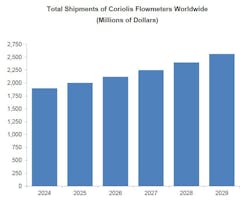Coriolis flowmeters keep dominating worldwide flowmeter market
The global Coriolis flowmeter market is projected to expand on multiple fronts, and grow at a 6.2% compound annual growth rate (CAGR) from $1.9 billion in 2024 to more than $2.4 billion by 2029, according to a new study, The world market for Coriolis flowmeters, 8th edition, by Flow Research.
First introduced by Micro Motion in 1977, Coriolis flowmeters consistently outperform much of their flow-measuring competition, and expanded in multiple disciplines and process applications during the past 40 years. More recently, suppliers continue to push the performance envelope for Coriolis meters in various ways. Coriolis meters are also more accurate than ever, while their diagnostic software provides constant performance monitoring, and helps predict when recalibration is needed. Meanwhile, straight-tube meters, both single and dual, are addressing fluid-clogging issues experienced by some bent-tube meters. They also have minimal straight-run requirements upstream and downstream, and offer easier installation. Because of their compact construction, they also fit into tight spaces more easily.
“It’s hard to overstate the importance of Coriolis flowmeters to the broader flowmeter market,” says Dr. Jesse Yoder, president of Flow Research. “Coriolis suppliers have consistently done extensive product research and development to improve these meters in many ways. These include accuracy levels, construction materials, line sizes, bent- and straight-tube types, and developing models for specific applications.”
In addition, Coriolis flowmeter suppliers are launching new products at both ends of the size spectrum. More suppliers now offer Coriolis meters in line sizes from 6 to 16 inches in diameter. These meters tend to be quite large and heavy, but are valued for custody transfer of petroleum liquids and natural gas. On the smaller side, suppliers are producing 1/16th-inch Coriolis meters for applications such as injecting chemical catalysts or treatment chemicals into pipelines.
Other uses include dosing, batching small pharmaceuticals, food ingredients and specialty chemicals. Smaller Coriolis flowmeters are also used for manufacturing fragrances, expensive additives and special fluids. Some meters are made as small as 1/32nd inch for laboratory applications, though they tend to be fragile and more subject to clogging.
Represented by the 2- to 4-inch pipe sizes, Coriolis flowmeters also compete with ultrasonic and turbine meters. Coriolis meters are approved by APA-11 for fiscal metering of natural gas, and their high accuracy makes them desirable in these line sizes. They’re used for precise measurement of natural gas fed to boilers, furnaces and turbines. Other uses include CNG and LNG distribution and filling stations. Coriolis meters compete strongly here because accuracy at low and varying flowrates is critical, and density information is valuable.
The distinction between purchase prices and total cost of ownership (TCO), or lifecycle costs, favors Coriolis meters. Even though Coriolis meters cost more than many other flowmeters, they may be less expensive over a meter’s lifetime due to reduced maintenance. Unlike turbine and positive displacement meters, Coriolis meters don’t have moving parts apart from their vibrating tube. They’re not subject to wear in the same way as orifice plates. With many companies reducing their engineering and maintenance personnel, having flowmeters that don’t require as much maintenance can be a major advantage, and accrue savings over time.
“One of the latest and most critical measurements is hydrogen and renewable natural gas (RNG), in addition to CNG and LNG,” adds Yoder. “Expect Coriolis meters to be at the forefront of measurements required for the energy transition. These meters will almost certainly continue on their upward trajectory as suppliers release new products.”
Coriolis flowmeters will also likely be aided by physical improvements, such as using stronger and lighter materials like titanium that extend the meter life. Likewise, recently introduced sensor-tube materials such as super duplex increase resistance of flowmeters to pitting corrosion, which occurs when small cavities form in the flow-tube walls. These new materials let flowmeters handle corrosive fluids that previously would have distorted flowrate measurements due to internal erosion of sensor tubes made from less corrosive-resistant material.
About the Author

Leaders relevant to this article:

